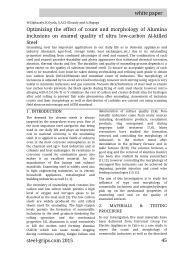Enameling steel has important applications in our daily life as in domestic appliances and industry (chemical, agro-food, storage tanks, heat exchangers..etc.) due to its outstanding properties resulting from combined advantages of steel and enamel. The combination of such steel and enamel provides durability and glossy appearance that withstand chemical corrosion, abrasion, thermal shocks and fire. The durability and quality of enameling process depends to a great extent on the quality of substrate (enamel steel). To ensure an acceptable quality of such steel to be enameled, care must be taken during steelmaking and refining such grade to obtain low carbon levels (0.03-0.05%max) and minimum count of inclusions. The morphology of inclusions is adjusted by Ca-cored wire feed technology however melt stirring using Argon is very useful to minimize inclusions and gas contents. Vacuum decarburization of steel melt to ensure low carbon levels prevents the black specks during firing of such steel sheets; however micro-alloying with 0.2-0.5% Ti or V stabilizes the rest of carbon and creates default sites for hydrogen after cold rolling to prevent fish scale phenomena after enameling. Assessment of inclusion counts and their morphology as well as distribution of carbides are carried out using scanning field electron microscopy and ASTM standard.
Optimizing the effect of count and morphology of Alumina inclusions on enamel quality of ultra low-carbon Al-killed Steel


